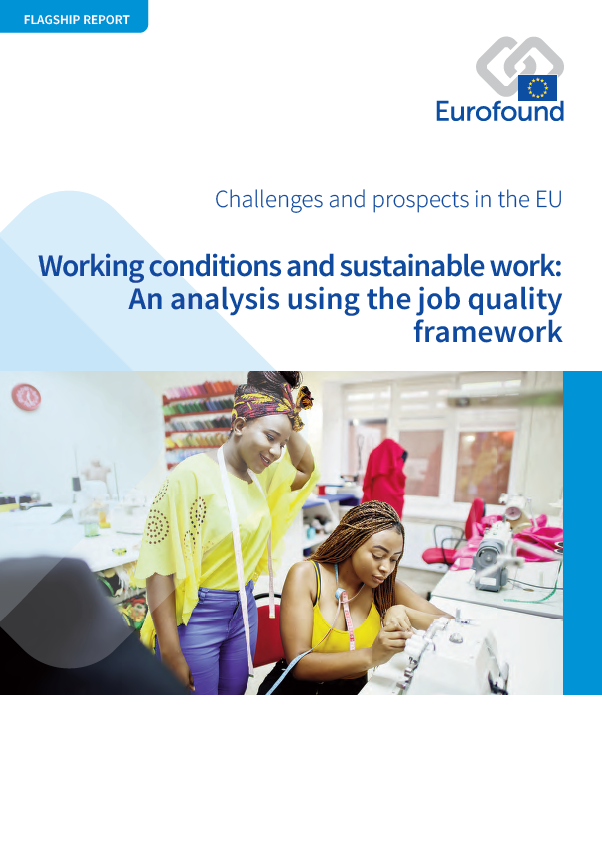
Ce rapport phare résume les principales conclusions des recherches d’Eurofound sur les conditions de travail menées au cours de la période de programmation 2017-2020. Il recense les progrès accomplis depuis 2000 dans l’amélioration des conditions de travail et examine si tous les travailleurs ont bénéficié de cette évolution positive de manière égale. Il met en évidence les groupes les plus exposés au risque de connaître des conditions de travail médiocres et d’être laissés pour compte. Les défis émergents pour une bonne qualité de l’emploi sont identifiés, eu égard à l’évolution du monde du travail. Le rapport fournit également des éléments probants pour des mesures susceptibles d’améliorer encore le travail et de garantir des conditions de travail équitables pour tous dans l’Union.
Cette analyse montre que, dans l’ensemble, la qualité de l’emploi dans l’Union s’améliore, quoique lentement. Néanmoins, tous les travailleurs n’en bénéficient pas dans la même mesure. En outre, le sexe, l’âge et le statut contractuel ont une incidence significative sur les conditions de travail d’une personne. Si la numérisation contribue à remédier à certains problèmes de qualité de l’emploi, elle engendre également de nouveaux défis. La pandémie de COVID-19 a exacerbé ces tendances, en renforçant les inquiétudes et en soulignant l’importance de parvenir à la qualité de l’emploi pour tous.
Key findings
En moyenne, les travailleurs de l’Union européenne bénéficient de meilleures conditions de travail aujourd’hui qu’au début du millénaire. Non seulement, la qualité du temps de travail s’est nettement renforcée, mais l’environnement physique est également meilleur, surtout là où il compte le plus: dans les professions ayant une exposition élevée aux risques physiques.
Les emplois d’aujourd’hui exigent davantage de compétences et offrent plus d’autonomie que par le passé. Cela se traduit par une amélioration de l’indice de compétences et de latitude de décision.
Le perfectionnement des compétences des travailleurs est entravé par l’inégalité d’accès et de recours aux formations rémunérées par l’employeur. Les travailleurs plus âgés participent moins aux formations et l’on constate un écart croissant dans l’accès à la formation rémunérée entre les salariés ayant des statuts contractuels différents (temps plein par rapport à temps partiel et contrats à durée indéterminée par rapport à contrats à durée déterminée).
La persistance de la ségrégation entre les femmes et les hommes sur le marché du travail se traduit par des différences en matière de qualité de l’emploi entre les sexes. Il n’y a cependant pas de grand gagnant. Les disparités entre les hommes et les femmes peuvent également être préjudiciables aux hommes, par exemple en ce qui concerne l’environnement physique.
Si les perspectives de carrière se sont généralement améliorées pour les deux sexes, les hommes ont conservé leur avantage dans cette dimension de la qualité de l’emploi. Le partage inégal des responsabilités familiales, qui se manifeste par des interruptions de carrière plus longues et des aménagements du temps de travail différents pour les femmes, en est la cause probable.
Based on the European Working Conditions Survey (EWCS) 2015 analysis, the data below accompany Eurofound's flagship report on working conditions and sustainable work and focus on job quality for different occupational profiles.
- Data: Job quality in the EU
The flagship report also has the following list of tables and figures.
List of tables
Table 1: Change in the composition of the workforce, EU27 and the UK, 2002–2019
Table 2: Elements of the job demands–resources model based on the EWCS
List of figures
Figure 1: The seven dimensions of job quality and the indicators composing each dimension
Figure 2: Indexed change in job quality indices, EU27 and the UK, 2000–2015
Figure 3: Physical environment index: mean and standard deviation, by occupational category, EU27 and the UK, 2000–2015
Figure 4: Work intensity index: mean and standard deviation, by sector, EU27 and the UK, 2000–2015
Figure 5: Work intensity index: mean and standard deviation, by country cluster, EU27 and the UK, 2000–2015
Figure 6: Skills and discretion index: mean and standard deviation, by occupational category, EU27 and the UK, 2000–2015
Figure 7: Skills and discretion index: mean and standard deviation, by country cluster, EU27 and the UK, 2000–2015
Figure 8: Participation in paid training (%), by employment and contractual status, EU27 and the UK, 2005–2015
Figure 9: Associations between working time quality and occupational category, by country cluster
Figure 10: Working time quality index: mean and standard deviation, by country cluster, EU27 and the UK, 2000–2015
Figure 11: Long working hours (%), by employment status, EU27 and the UK, 2000–2015
Figure 12: Prospects index: mean and standard deviation, by occupational category, EU27 and the UK, 2005–2015
Figure 13: Prospects index: mean and standard deviation, by country cluster, EU27 and the UK, 2005–2015
Figure 14: Scores on Prospects index, by employment and sociodemographic characteristics, EU27 and the UK, 2005 and 2015
Figure 15: Receipt of support from colleagues and managers (%), EU27 and the UK, 2005–2015
Figure 16: Receipt of support from colleagues and managers (%), by age group, EU27 and the UK, 2005 and 2015
Figure 17: Exposure to adverse social behaviour (%), by gender, EU27 and the UK, 2010 and 2015
Figure 18: Perception of fair pay (%), by Member State and the UK, 2005–2015
Figure 19: Perceived appropriateness of pay, by country cluster, EU27 and the UK, 2005–2015
Figure 20: Job quality profiles: Scores on seven job quality indices, EU27 and the UK, 2015
Figure 21: Distribution of workers according to job quality profiles, EU27 and the UK, 2015
Figure 22: Job quality profiles of men, by job quality indices, EU27 and the UK, 2015
Figure 23: Job quality profiles of women, by job quality indices, EU27 and the UK, 2015
Figure 24: Distribution of employees according to predominant gender in occupation (%), by gender, EU27 and the UK, 2010 and 2015
Figure 25: Gender of immediate manager (%), by worker’s gender, EU27 and the UK, 2005–2015
Figure 26: Female employees reporting good prospects for career advancement and gender gap (%), EU27 and the UK, 2005–2015
Figure 27: Good prospects for career advancement (%), by age and gender, EU27 and the UK, 2005–2015
Figure 28: Job insecurity according to predominant gender in occupation (%), by gender, EU27 and the UK, 2010 and 2015
Figure 29: Employability according to predominant gender in occupation (%), by gender, EU27 and the UK, 2010 and 2015
Figure 30: Employees reporting difficulty making ends meet according to occupation type (%), by gender, EU27 and the UK, 2015
Figure 31: Employees reporting difficulty making ends meet according to household type (%), by gender, EU27 and the UK, 2015
Figure 32: Employee experience of selected emotional demands (%), by gender, EU27 and the UK, 2010 and 2015
Figure 33: Average weekly working hours of employees across the life course, by gender, EU27 and the UK, 2015
Figure 34: Flexibility to take time off according to predominant gender in occupation (%), by gender, EU27 and the UK, 2010 and 2015
Figure 35: Additional components of earnings from main job (%), by gender, EU27 and the UK, 2005–2015
Figure 36: Employees’ perception of their work–life balance (%), by age, EU27 and the UK, 2015
Figure 37: Employees’ participation in training (%), by age and training classification, EU27 and the UK, 2015
Figure 38: Associations between demands and resources and workers’ health and well-being
Figure 39: Proportion of workers with flexitime schedules and engaged in TICTM (%), EU27 and the UK, 2015
Figure 40: Workers reporting work–life balance problems (%), by work arrangement and presence or absence of children, EU27 and the UK, 2015
Figure 41: Multiple-job holders as a proportion of total employment (%), by gender and country, EU27 and the UK, 2018
Figure 42: Job quality profiles of multiple-job holders’ main jobs, by gender, EU27 and the UK, 2015
Figure 43: Job quality of selected critical occupations in relation to the workforce average
Figure 44: Emotional demands on ISWs and extent of those demands (%), EU27 and the UK, 2015
- Number of pages
-
80
- Reference nº
-
EF20021
- ISBN
-
978-92-897-2150-9
- Catalogue nº
-
TJ-03-21-030-EN-N
- DOI
-
10.2806/938302
- Permalink
Members of Eurofound’s Management Board provide their reactions to and insights into Eurofound’s 2021 flagship report on Working conditions and sustainable work: An analysis using the job quality framework.
- Impact of the Covid-19 pandemic
Interview with Juha Antila, Head of Research and Development SAK, Central Organisation of Finnish Trade Unions.
- Digitalisation
Interview with Mario van Mierlo, Deputy Director, Social Affairs, The Dutch Confederation of Industry and Employers (VNO-NCW).
- Making work sustainable
Interview with Alain Piette, Ergonomist at the Belgian Federal Public Service Employment, Labour and Social Dialogue.
- Role of different actors in improving job quality
Interview with Rebekah Smith, Deputy Director for Social Affairs, BusinessEurope.
- Persisting challenges
Interview with Nelson Ferreira, Deputy General Inspector ACT, Portugal Labour Conditions Authority.
- Remote working
Interview with Esther Lynch, Deputy General Secretary of the European Trade Union Confederation (ETUC).
Cite this publication
Eurofound (2021), Working conditions and sustainable work: An analysis using the job quality framework, Challenges and prospects in the EU series, Publications Office of the European Union, Luxembourg.
